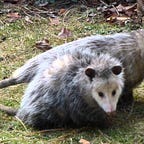The Ghosts Of Madagascar: Why The Lemurs Scream And The Plants grow Spikes
To the rest of the world, Madagascar’s wilderness appears as a peculiar, remixed version of theirs. Its remaining nature, threatened by development, hosts animals only distantly familiar. Instead of big cats, the Fossa, a relative of the mongoose, prowls the undergrowth, holding an uncanny resemblance to a cougar. It hunts the many lemurs which adapted to fill available niches on the island, such as the Aye-Aye. Without any Malagasy woodpeckers to compete with, these creepy, pale-faced lemurs with yellow, beady eyes, took their role. Using their long, bony middle fingers like a woodpecker’s beak, they dig holes into trees in search of grubs. The largest lemur species, the ring-tailed lemur, must also avoid predation from these cat-like mongooses as they scavenge for food and defend their territory.
When they do find themselves in danger, ring-tailed lemurs make distress calls, which alert others to the presence of a predator. Curiously, these lemurs make calls at large birds of prey, like the Madagascar Harrier-Hawk. This puzzled scientists as no Malagasy birds of prey are large enough to attack an adult ring-tailed lemur.
That was until archaeologists found the remains of a massive eagle in the dig site of Ampasambazimba in central Madagascar. These bones belonged to the Malagasy crowned eagle, a bird large enough to take down a ring-tailed lemur. Judging by its extant cousin the African crowned eagle, with a record wingspan of 6 ft 3 in, these birds would dwarf their prey. The fear that the remaining large birds of Madagascar instill into these lemurs likely originates from when they had to survive attacks from these human-sized birds.
These eagles soared across Madagascar as recently as 1500 AD, suggesting that the lemurs’ calls are an example of Evolutionary Anachronism. Evolutionary biologist Connie Barlow, in her book The Ghosts Of Evolution, defines this term as when an organism “is suited for a world that no longer exists.” When two organisms coevolve, or adapt because of each other, and one goes extinct, the survivor is left with an evolutionary anachronism.
Such anachronisms are everywhere. The spiny forests which define southern Madagascar perfectly encapsulate this. This unique ecoregion, unlike anything else on earth, hosts a diverse array of plants, 95% of which being endemic to the island. This dry, yet vegetated landscape is dominated by the massive Baobab trees and the Alluaudia- woody, cactus-like flowering plants, covered in large spikes which protect their leaves. But these leaves are rarely eaten by any extant animal, suggesting these spikes defend against a now-extinct species.
Indeed, archaeologists discovered the remains of many possible candidates of the mystery predator within an underwater cave in the region. Among the bones collected, there were horned crocodiles, mini hippopotamuses, elephant birds that stood taller than ostriches, and giant lemurs. Using isotope testing, anthropologists Brooke E. Crowley and Laurie R. Godfrey determined that the extinct monkey lemurs likely fed upon these plants, which drove them into an evolutionary arms race, where the plant grew bigger and bigger spikes to discourage feeding on its valuable leaves.
But what made all of these animals go extinct? The many bizarre creatures found in this cave lived around the same time as the Malagasy crowned eagle, which makes some researchers suspect that humans are to blame. Crowley suggests that the reason for the decline and eventual extinction of all of Madagascar’s megafauna 1000 to 500 years ago was humans. Unsustainable hunting practices and the burning of large swaths of forest to make way for human settlement and cattle grazing increased at this same time, as the Malagasy population grew. In a trend common to large, extinct animals across the world, Madagascar’s megafauna died out because their large size required more resources and land at a time when resources and land were disappearing.
The whispers of Madagascar’s past left behind in the form of these evolutionary anachronisms give us insight into what Madagascar looked like before its human-made mass extinction. This information is valuable because Madagascar’s extinction event never ended. Today, habitat loss continues as the demand for charcoal increases. Deforestation of pristine ecosystems remains unimpeded by any form of regulation. The International Union for Conservation of Nature’s (IUCN) Red List ranks both the aye-aye and the ring-tailed lemur as endangered, while the Fossa is threatened. The spiny forests of southern Madagascar as a whole face near elimination, as only 3% of this valuable ecoregion is nationally protected.
As Madagascar’s natural richness disappears, these anachronisms will only continue to grow in number. Soon, the remaining lemurs may scream at introduced cats, mistaking them for the extinct Fossa. Grubs may continue boring deep into tree trunks, in hopes of avoiding the nonexistent aye-ayes. Restoring Madagascar’s wilderness begins with protecting the habitats that remain intact.
